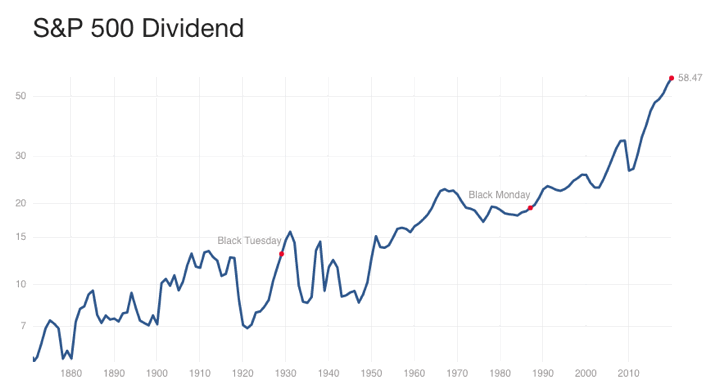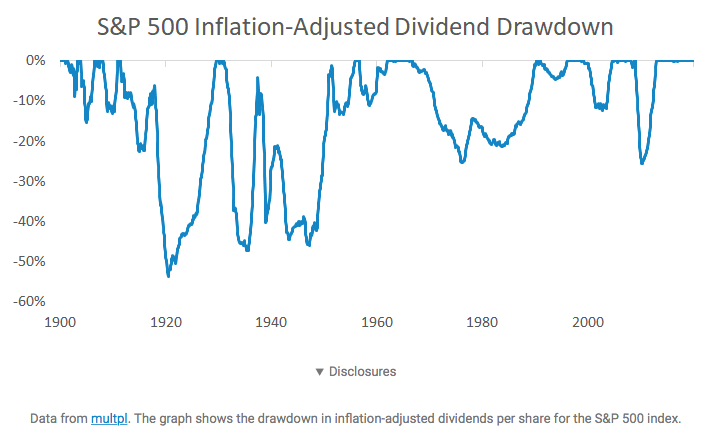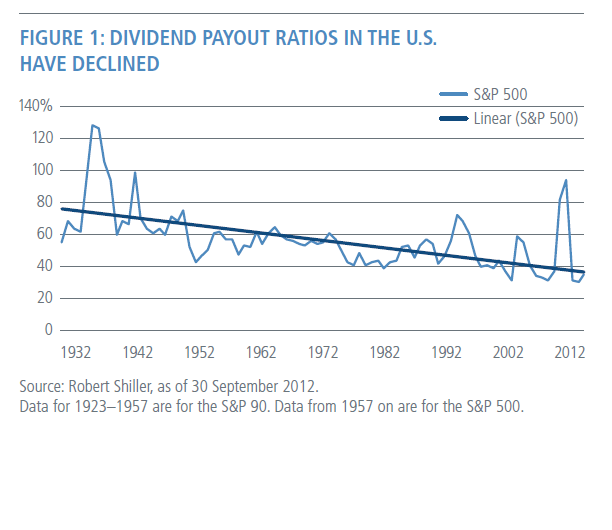 While we see the live price of the S&P 500 index everywhere, there is much less talk about its dividends. Dividends are an important component of the total return from stocks. I love seeing my quarterly dividend payments arrive every quarter, and combined with our reduced work income, they are enough to cover our household expenses. How reliable is the income stream from owning an S&P 500 index fund (or similar total market fund)?
While we see the live price of the S&P 500 index everywhere, there is much less talk about its dividends. Dividends are an important component of the total return from stocks. I love seeing my quarterly dividend payments arrive every quarter, and combined with our reduced work income, they are enough to cover our household expenses. How reliable is the income stream from owning an S&P 500 index fund (or similar total market fund)?
Here is the growth of the 12-month dividend per share of the S&P 500 on an inflation-adjusted basis (source).

Looks pretty good overall, but how bad were those drops? Inside this Movement Capital article about managing sequence-of-return risk, I came across a helpful chart showing the historical drawdowns of dividends (inflation-adjusted) from the S&P 500 index since 1900.

William Bernstein has been quoted as saying that you can only treat 50% of your dividend income as reliable. Below is an excerpt from his book The Ages of the Investor that provides more context:
If you counted on your stock holdings to see you through retirement, you’re likely to be seriously disappointed. Yet, there is a small part of the equity portfolio that can be considered in the funding of retirement: the “safe dividend flow” from stock holdings. Although the value of stocks can fluctuate wildly, their stream of income is much more stable. At no point in the history of the U.S.stock market has its real dividend stream fallen by more than half, even during the Great Depression. During the most recent financial crisis, for example, although stock prices fell by more than 50%, dividends also dropped, but by only 23% from their peak, and only temporarily.
That pretty much agrees with the top chart. Dividends have dropped by up to 50%, but it has not dropped that much since around 1950. Since about 1950, the greatest drawdown of overall S&P 500 dividends has been about 25%.
Dividend payout ratio. The dividend payout ratio is the percentage of net income that a business pays out as dividends. For example, a company might earn $10 a share in net profits and pay $6 a share as a dividend. That is a dividend payout ratio of 60%. In the 1930s and 1940s, the dividend payout ratio consistently averaged above 60% (source). The majority of profits were paid out to shareholders. However, since then the dividend payout ratio has been dropping, with the average now in the 30% to 40% range (chart source):

In theory, it should be much easier to maintain a dividend when you are only paying out 30% of profits as cash, as opposed to 60% of profits as cash. Of course, anything can happen. At the minimum, your withdrawal plan should be prepared for a 25% drop in dividends at some point in the future.
Bottom line. The S&P 500 dividend has dropped by up to 50%, but it has not dropped that much since around 1950. S&P 500 businesses have been steadily decreasing the percentage of profits being paid out as cash dividends. Today, dividends only account for about 30% of overall profits (not 60%+). In theory, this should make the dividend less prone to large cuts.
 The Best Credit Card Bonus Offers – 2025
The Best Credit Card Bonus Offers – 2025 Big List of Free Stocks from Brokerage Apps
Big List of Free Stocks from Brokerage Apps Best Interest Rates on Cash - 2025
Best Interest Rates on Cash - 2025 Free Credit Scores x 3 + Free Credit Monitoring
Free Credit Scores x 3 + Free Credit Monitoring Best No Fee 0% APR Balance Transfer Offers
Best No Fee 0% APR Balance Transfer Offers Little-Known Cellular Data Plans That Can Save Big Money
Little-Known Cellular Data Plans That Can Save Big Money How To Haggle Your Cable or Direct TV Bill
How To Haggle Your Cable or Direct TV Bill Big List of Free Consumer Data Reports (Credit, Rent, Work)
Big List of Free Consumer Data Reports (Credit, Rent, Work)
Thanks for this. With everything that’s happening, it’s important to put the recent declines in perspective, particularly for longterm investors.